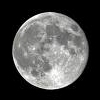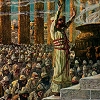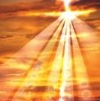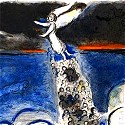|
AFTER THE LORD DELIVERED THE JEWS from slavery in Egypt, He said, "Follow me into the wilderness, into an unsown land" (Jer. 2:2). Over two million people - men, women, and children - heeded the call and left for the Promise of God.
Now the desert is a hard, dry place. Unless you were prepared with provisions and protection, a trek through it could be life-threatening, perhaps even suicidal. But consider what it must have been like for two million people! What would they eat or drink? Where would they find shelter? How would they avoid the scorpions, snakes, and other perils?
In a word, the LORD Himself sheltered the Jews with Clouds of Glory and supernaturally provided for them during their 40 years of wandering in the desert after the Exodus. God performed miracle upon miracle, sustaining the people in the midst of the desert and its dangers.... Consequently, He commanded Moses that these acts of Divine Chesed be commemorated as the festival of Sukkot (Lev. 23:34; Deut. 16:13-16).
The word sukkot (ūĪų╗ūøų╝ūĢų╣ū¬) is the plural of the Hebrew word sukkah (ūĪų╗ūøų╝ųĖūö), meaning a "booth" or "hut." In traditional Judaism, a sukkah is a temporary structure used for "living in" (i.e., primarily eating meals or entertaining guests) throughout the eight day festival of Sukkot ("Tabernacles"). The purpose of the sukkah is to remind us of the type of huts the ancient Israelites dwelt in as they made their trek through the dangers of the desert.
According to halakhah (Jewish law), the minimal sukkah must have two complete walls with a third wall at least the "length of a handbreadth." The walls can be made from any material, though the structure must be covered with a "schach" (ūĪūøūÜ, thatched roof) made from only organic material (representing the Clouds of Glory). It is customary to decorate the sukkah by hanging fruit from the schach and adding other decorations. Since a sukkah minimally is contructed of two walls (that resemble a bent arm) and a third wall (that resembles a hand), some of the sages says it represents God's arm wrapping around us to give us shelter (a "divine hug"). The traditional view, however, is that the Sukkah is meant to remind us of the Clouds of Glory that protected the Jewish people while they sojourned in hostile and dangerous desert conditions.

The Torah states that we are to rejoice during the appointed time of Sukkot - samachta b'chagekha (ū®ūéųĖū×ųĘūŚų░ū¬ų╝ųĖ ūæų╝ų░ūŚųĘūÆų╝ųČūÜųĖ) - and immediately reiterates that we are to be "altogether joyful" - hayita akh sameach (ūöųĖūÖų┤ūÖū¬ųĖ ūÉųĘūÜų░ ū®ūéųĖū×ųĄūŚųĘ). (Deut. 16:14-15) For this reason, the sages called the eight days of Sukkot "Z'man Simchatenu," the time of our happiness.
Why Rejoice?
But why are we commanded to "rejoice" and be "altogether joyful" during the season of Sukkot? Here are a few reasons:
- First, the festival recalls the great Exodus from Egypt and the miracles that God performed on behalf of the Jewish people. Since we are related to them and owe our faith to them, we should therefore be thankful and rejoice at God's sustaining care and providence of our faithful ancestors.

- Second, God Himself "tabernacled" with the camp of Israel in the wilderness. God's Sukkah is called the mishkan (ū×ų┤ū®ūüų░ūøų╝ųĖū¤), a word rendered as skeine (Žā╬║╬Ę╬Į╬Ę) in the Greek translation (LXX). Moses was given the design for the mishkan on Sinai so that the LORD Himself would dwell in a tent in the midst of the people of Israel: shakhanti b'tokham - "that I may dwell among them" (Exod. 25:8). The covering of God's Sukkah was actually the cloud of God's Glory (Exod. 40:35-36). The Apostle Paul referred to the Jews being immersed ("baptised") by the surrounding Shekhinah Glory of God in their midst (1 Cor. 10:1-2).

- Third, after settling in the Promised Land, Sukkot became associated with the Festival of Fall Harvest, Chag Ha'asif (ūŚųĘūÆ ūöųĖūÉųĖūĪų┤ūŻ), or the "Feast of Ingathering" (Exod. 23:16, 34:22). This was an autumnal celebration of thanksgiving for the fruit harvest, held during the full moon of Tishri.

- Fourth, King Solomon dedicated the Jewish Temple on Sukkot (1 Kings 8; 2 Chron. 7). The Shekhinah glory of the LORD descended to light the fire on the altar and filled the Holy of Holies (1 Kings 8; 2 Chron. 7:1-10).

It later became customary (based on Deut. 31:10) that every seven years pilgrims would gather in the Temple Courtyard during Sukkot to listen to the reigning king read passages from the Torah. This ceremony was called Hakhel (ūöųĘū¦ų░ūöųĄū£, "assemble"), and it certainly was a joyful time.
- Fifth, the Scriptures record that Sukkot was the very first holiday observed after the Babylonian captivity, when the Second Temple was dedicated (Ezra 3:2-4).
- Sixth, over time Sukkot became the single most important festival held in the Promised Land, called "the Feast of the Lord" (ūŚųĘūÆųŠūÖūöūĢūö, Lev. 23:39; Judges 21:19) or simply "the Feast" (1 Kings 8:2, 65; 12:32; 2 Chron. 5:3; 7:8). Along with Passover and Shavuot, Sukkot is one of the three "pilgrimage festivals" that united all Israel in holy celebration. Pilgrims from all over Israel (and indeed the world) would annually come together and erect countless colorful booths near the Temple. They would purchase their four species (arba minim), light campfires, decorate their sukkas, and make themselves merry in celebration of the fall harvest. They eagerly anticipated the famous Water Drawing Ceremony of the Temple (nisuch ha-mayim), the dramatic light shows, the special music and the waving of lulav.... After the solemnity of Yom Kippur, Sukkot was a time of camping out and rejoicing in the LORD's provision and love.
- Seventh, it's likely that Yeshua (Jesus) was born during Sukkot, since the same verb that says He "dwelt" with us (Žā╬║╬Ę╬Į╬┐Žē in John 1:14) derives from the same root used in the LXX to refer to both the mishkan (Tabernacle) and the individual tents of Sukkot (Žā╬║╬Ę╬Į╬┐Žé). As Mashiach ben Yosef, He attended the festival but did so "secretly" (John 7:8-10); when He comes again as Mashiach ben David, it will be openly, with the "Clouds of Glory" (Matt. 24:30, Rev. 1:7). Note also that the two great themes of Sukkot (during the Second Temple period) were 1) water, and 2) light. It's likely that Yeshua referred to Himself as both the "Living Water" (John 7:38) and the Light of the world (John 8:12) during the "drawing of the house of water" ceremonies during this festival.

- Finally, when Yeshua returns to establish the Messianic Kingdom on earth, He will once again "tabernacle" with Israel in Jerusalem (Ezek. 37:27-28; Rev. 21:3). The visible manifestation of the LORD, the Shekhinah glory, will be seen as a shining fire over all of Mount Zion (Isa. 60:1,19, Zech. 2:5), and all of the nations of the earth will journey to there to celebrate Sukkot (Zech. 14:16-19). "Then the LORD will create over the whole site of Mount Zion and over her assemblies a cloud by day, and smoke and the shining of a flaming fire by night; for over all the glory there will be a canopy" (Isa. 4:5).
Note: This hope is expressed in the prayerbook blessing for the end of Sukkot: "May it be Your will, Adonai our God and the God of our forefathers, that just as I have fulfilled the mitzvah and dwelled in this (earthly) sukkah, so may I merit in the coming year to dwell in the Sukkah of the Skin of the Leviathan."
Midrash says that in the world to come the Messiah will cause the "Leviathan" (a giant fish created on the 5th day of creation) and the "behemoth" (a giant ox) to destroy one another (Leviticus Rabbah 13:3). From the beautiful skin of the Leviathan God will construct sukkas to shelter the righteous (Bava Basra 75a). The remainder of Leviathan's skin will stretched out over Zion as a canopy, and the light streaming from it will illumine the whole world. This is sometimes called "the Sukkah of the Skin of Leviathan." Within these canopies, the righteous will eat the meat of the Leviathan and the behemoth in great joy.
But how is the modern observance of celebrating in a sukkah supposed to be joyful? After all, the usual amenities of life are missing there.... How does "dwelling" in a frail little hut invite us to be happy?

Sukkot reminds us that we are sojourners, too, just passing through.... Like father Abraham, we live in a foreign land as ger v'toshav - "strangers and sojourners," looking forward to the City of God (Heb. 11:9-10). We do not need the so-called securities that this world can offer us -- including a stable economy or stock market -- to be happy and provided for, chaverim -- not if we truly understand that we are surrounded by God's sheltering Presence. What more could we want, especially as we consider this fleeting and moribund world we live in? As Paul said:
This slight momentary affliction is preparing for us an eternal weight of glory beyond all comparison, as we look not to the things that are seen but to the things that are unseen. For the things that are seen are transient, but the things that are unseen are eternal. For we know that if the tent (Žā╬║╬Ę╬Į╬┐Žé), which is our earthly home, is destroyed, we have a building from God, a house not made with hands, eternal in the heavens. For in this tent we groan, longing to put on our heavenly dwelling.
(2 Cor. 4:17-5:2)
|








